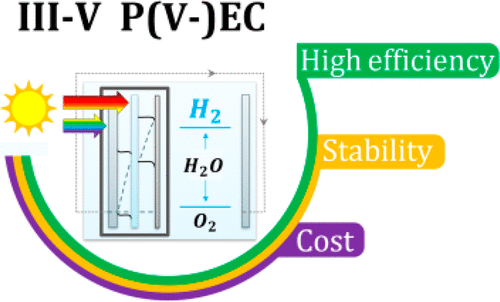当前位置:
X-MOL 学术
›
ACS Energy Lett.
›
论文详情
Our official English website, www.x-mol.net, welcomes your feedback! (Note: you will need to create a separate account there.)
III–V Semiconductor Materials for Solar Hydrogen Production: Status and Prospects
ACS Energy Letters ( IF 22.0 ) Pub Date : 2020-01-29 , DOI: 10.1021/acsenergylett.9b02582 Julie Tournet 1 , Yonghwan Lee 1 , Siva K. Karuturi 1, 2 , Hark H. Tan 1 , Chennupati Jagadish 1
ACS Energy Letters ( IF 22.0 ) Pub Date : 2020-01-29 , DOI: 10.1021/acsenergylett.9b02582 Julie Tournet 1 , Yonghwan Lee 1 , Siva K. Karuturi 1, 2 , Hark H. Tan 1 , Chennupati Jagadish 1
Affiliation

|
Following recent developments in photoelectrochemical and photovoltaic–electrosynthetic systems, we present the benefits of III–V semiconductors for solar water splitting. In addition to their interesting light absorption and carrier transport properties, III–V alloys and multijunction structures enable the highest solar-to-hydrogen conversion efficiencies. However, many obstacles still stand in the way of practical realization of III–V solar water-splitting systems. Various surface protection strategies are being developed to address the instability of III–V semiconductors in an electrolyte. Meanwhile, multiple cost-reduction approaches are being implemented, including the use of solar concentration, epitaxial lift-off or spalling for substrate reuse, and monolithic or heterogeneous integration on silicon substrates. All these advances make III–V photoabsorbers a promising route toward decarbonated hydrogen production and pave the way to long-term deployment in real-world applications.
中文翻译:

用于太阳能制氢的III–V半导体材料的现状与前景
继光电化学和光生伏打电子合成系统的最新发展之后,我们介绍了III-V半导体在太阳能水分解中的优势。除了具有有趣的光吸收和载流子传输特性外,III-V合金和多结结构还具有最高的太阳能到氢的转换效率。但是,III-V型太阳能水分解系统的实际实现仍然存在许多障碍。正在开发各种表面保护策略来解决电解质中III–V半导体的不稳定性。同时,正在实施多种降低成本的方法,包括利用太阳能集中,外延剥离或剥落以重复使用基板,以及在硅基板上进行单片或异质集成。
更新日期:2020-01-29
中文翻译:

用于太阳能制氢的III–V半导体材料的现状与前景
继光电化学和光生伏打电子合成系统的最新发展之后,我们介绍了III-V半导体在太阳能水分解中的优势。除了具有有趣的光吸收和载流子传输特性外,III-V合金和多结结构还具有最高的太阳能到氢的转换效率。但是,III-V型太阳能水分解系统的实际实现仍然存在许多障碍。正在开发各种表面保护策略来解决电解质中III–V半导体的不稳定性。同时,正在实施多种降低成本的方法,包括利用太阳能集中,外延剥离或剥落以重复使用基板,以及在硅基板上进行单片或异质集成。



























 京公网安备 11010802027423号
京公网安备 11010802027423号